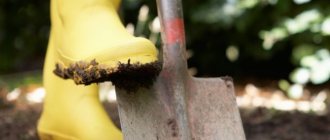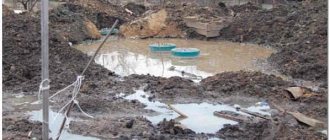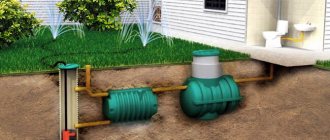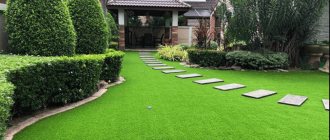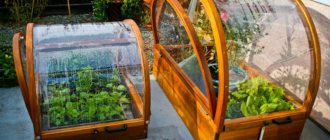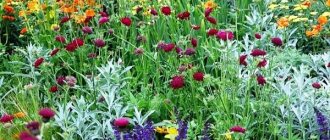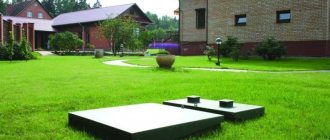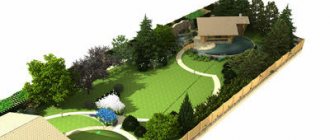A neatly decorated plot with designated areas for planting various vegetable and fruit crops, with beautiful flower beds and a smooth lawn is the dream of every gardener. But in many cases, homesteads are given to new owners in a neglected state. Despite the apparent complexity of the work ahead, you should not give up and spend money on attracting outside help. There are several simple and affordable ways to independently, without much effort, remove weeds from an overgrown area and put it in order.
Step-by-step action plan
It will be easier to master a new area if you break the process into separate tasks and then complete them one after another. Then a clear picture will immediately form in your head - what is most important, where to start, what can be left for later.
This will relieve the state of some confusion in which owners of neglected areas often find themselves.
Pre-planning will also help to avoid annoying mistakes that can complicate the life of a summer resident and add more work to him.
The development of an overgrown area can be divided into the following stages:
- Cleaning the area.
- Removing unnecessary trees and shrubs.
- Tidying up the remaining trees and bushes.
- Weed control.
- Preparing the soil for planting.
- Keeping the soil weed-free.
Why land plots may begin to be confiscated from Russians
Plots of land with uncut grass and littered with garbage may begin to be confiscated from owners for violating fire safety. Such a bill was prepared by the Ministry of Economic Development. We understand the initiative and tell you how to maintain fire safety in your dacha.
Photo: TASS/Maxim Stulov/Vedomosti
Why can the land be taken away?
The Ministry of Economic Development has developed amendments to the Land and Civil Codes of the Russian Federation, thanks to which land plots may begin to be confiscated from violators of fire safety rules. Violations include cases when the area is overgrown with weeds or a large amount of garbage accumulates there. A full list of grounds for seizure will be presented in a special government act.
First, the owner or tenant will be given an order to eliminate the violations. If the owner does not come to his senses within six months, the issue of confiscation of the plot will be resolved through the court. Then the land will be sold at open auction at market value, and the money received will be given to the owner, but minus the costs of preparing and holding auctions.
However, plots that are under mortgage, as well as lands whose owner is undergoing bankruptcy proceedings, will not be able to be taken away.
The amendments were developed in connection with the presidential decree “On measures to eliminate the consequences of natural fires in the Trans-Baikal Territory.” As a result of April natural fires in the Trans-Baikal Territory, hundreds of people lost their property. More than 30 people received injuries and burns. The acting governor of Transbaikalia called the human factor the cause of the fires.
According to government decree, owners or tenants of land plots are already required to regularly remove garbage and mow the grass. Otherwise, they may receive a fine.
Photo: portal of the mayor and government of Moscow
Safety for everyone or overkill?
Independent fire safety expert Denis Sebentsov told Moscow 24 that flammable garbage and dry grass on the site can really cause a serious fire.
“If someone has erected a building on their property, does not take care of it, does not cut the tall grass, reeds or burdocks, if then it all dries out and catches fire, then not only the neighboring buildings, but the entire village can burn,” he explained .
However, according to him, executive officials should not abuse this opportunity to seize land from violators.
“Authorized bodies must identify the owner, report this violation, which he may not even know about, give a period to correct the violation, and then, for the sake of collective security of the entire populated area, such a measure can be applied,” the expert added.
In turn, the leading expert of the Fire Safety Foundation, Konstantin Kuznetsov, believes that there is no need to seize sites for violations.
However, lawyer and leading specialist in land law Sergei Shugaev believes that mechanisms for the seizure of land plots are necessary to prevent violations of the law.
“There are numerous cases where summer cottages are used as landfills. People let cars with garbage go there, they charge money for it, they even get fined, but it doesn’t help. Also, these piles of garbage can be a fire hazard, so areas still need to be seized,” he believes.
At the same time, according to him, the final decision will still be made by the court.
“The owner must have the right to defend himself before an independent arbitrator and have the opportunity to correct the violations. After all, the court will not necessarily seize the land, since it evaluates all the circumstances. Maybe the person got sick and couldn’t monitor the site. Such a system will be fair, the balance will be maintained,” Shugaev emphasized.
The lawyer added that a similar mechanism is now in place for the seizure of agricultural land. According to him, municipalities can seize plots if they are used for other purposes.
Photo: TASS/Igor Akimov/Interpress
Cleaning the area
First you need to clear the area of household waste. These can be rags, fragments of bottles and bricks, boards, rusty pieces of iron and other objects that have no place in the beds.
Sometimes what remains from the previous owners is a real mini-dump, disguised with weeds or lightly sprinkled with earth.
However, you shouldn’t rush to throw everything away at once. Some things can be useful on the farm, especially at first. For example, boards, old buckets, large pieces of film, etc.
Now you need to walk around the area with a strong iron rake and comb out the old grass along with fallen leaves and twigs.
Dry standing stems of large weeds can be trimmed, cut with pruning shears or mowed with a sickle. All plant debris will be useful for laying a compost heap or warm beds.
Useful waste paper
This very original method will be effective if you carefully follow the instructions. To make it a reality, you will need rotted manure (you can use chicken manure, compost or humus). This composition must be evenly distributed over the entire area of the developed area and covered on top with black and white newspaper 5-7 layers thick. If you find this difficult, you can replace the newspaper with thick cardboard. Compost mixed with manure is poured onto the paper layer on top.
The advantage of this method is that you can make holes in newspapers in which you can plant any crops grown through seedlings. This is perfect for those who don’t want to wait a long time, being content with only potatoes and cabbage. At the end of the season, in addition to an excellent harvest of the crops you grow, you will also receive a clean area with soil enriched with vitamins and microelements.
Weed control
It will not be possible to completely get rid of weeds in an overgrown area in one season. This will require at least 2 years.
Typically, neglected areas are overgrown with perennial grasses such as gooseberry, wheatgrass, sow thistle, stinging nettle, etc. Such weeds are difficult to remove; you must immediately prepare yourself for a long and persistent fight against them.
If the area is covered with annual vegetation such as woodlice, acorn grass, white goosefoot, galinsoga and chickweed, then you can rejoice. It will be much easier to deal with them.
Without the help of chemicals, it will not be possible to quickly clear an overgrown area of weeds. This is especially true for large areas.
In a small area, it is still possible to eradicate weeds by constant mowing or plowing, but this will take a lot of time.
In addition, this will need to be done every two weeks. If you act manually, then in this way you can conquer only a small space from the virgin soil. If you hire heavy equipment, it will be very expensive.
To destroy harmful perennial weeds, it is better to use continuous herbicides based on glyphosate.
These are drugs such as Tornado, Roundup, Glyphos, etc. They spray the leaves of the weeds, and then wait 2-4 weeks until the poison reaches the roots and the plants die.
During this period, they cannot be mowed or pulled out of the ground. For the drug to work, there should be no rain for the first few hours after spraying.
Application of non-woven covering materials
If you need to free up a small piece of land and have at least a season left, you can use covering materials. The simplest and most effective are black non-woven covering materials - they are laid out on the site in the spring, choosing the most dense ones. Over the summer, the weeds will die under the geotextile, and at the end of the season it will be possible to plow the soil and apply fertilizers in order to begin processing in the spring.
Of course, the weed seeds will not disappear over the course of the year and will continue to sprout, but there will be significantly fewer of them.
You can replace geotextiles with any dense biodegradable material, for example, corrugated cardboard. It will serve the same, although it will look less presentable.
- Covering material for beds, greenhouses and greenhouses - which one is better to choose
How to choose a good covering material, and what exactly does your planting need? Let's explore the variety of colors and textures together!
If you are in a hurry and want to plant the first vegetables and berries this year, then install the frame directly on a layer of cardboard, fill it with fertile soil, brought to order or available to you, and then plant herbs, vegetables, strawberries in these ridge boxes etc. In a couple of years, the cardboard at the base of the ridge will decompose without a trace. But the covering material is not suitable for this; it will have to be removed in the fall.
Cutting down trees and bushes
First you need to assess the condition of the trees and shrubs growing on the site and decide which of them can be left and which are better to get rid of.
First of all, you should pay attention to their age, productivity, and health status.
Their location also matters - whether they obscure a large piece of land, whether they threaten buildings, or violate the interests of neighbors.
Tall trees, for example, should be no closer than 4 m from the boundaries of the adjacent area.
It should be borne in mind that in abandoned areas the trees are usually very neglected. Their restoration is a complex and long process. So sometimes it’s easier to plant new seedlings than to tidy up old plantings.
New areas often grow wild trees like pine or birch, which sometimes you want to leave for beauty. However, it is worth considering that many cultivated plants cannot develop normally near them.
It is important to remember that to remove trees, even on your own property, you may need a felling ticket, i.e., official permission for this procedure.
After cutting down trees and shrubs, stumps remain, which take up valuable space and spoil the appearance of the site. You can get rid of them in different ways:
- With the mechanical method, the stump is first dug up to expose as many roots as possible. They can also be released from the ground using a strong stream of water. Then the roots are cut off. After this, the stump is uprooted using a crowbar, a shovel or a hired bulldozer.
- With the chemical method, a fresh cut of the stump is treated with a herbicide. Its roots die and eventually decompose themselves. Such a stump will not sprout, and after 1–2 years it can be easily pulled out of the ground.
- With the biological method, the stump is not uprooted, but honey mushrooms are grown on it. To do this, several holes are made in it and pieces of mycelium brought from the forest are placed there. Then it is watered regularly, and after a few months the harvest is harvested. In a few years, the stump itself will turn into dust.
Stage 7: Arrangement of paths on the site
Floor tiles are most often used for paths and surfaces in areas. The method of its installation depends on its purpose.
For entrances and other places where heavy traffic is not planned, you can make a base of compacted crushed stone or coarse gravel. Then a layer of sand or a cement-sand mixture (cement-sand in a ratio of 1:9) is laid on it, and then stones, concrete or ceramic elements: slabs, FEM, paving stones, clinker.
For paths that will only be walked on, it is enough to make a base of well-compacted sand or a mixture of sand and cement.
Regardless of the type of covering being laid, you need to remember to form transverse slopes (1-2%), along which water after rain should flow onto lawns or under plants. Thus, you will not only speed up the drying process of paths and areas, but also, by accumulating water in the soil and allowing it to evaporate slowly, you will make a contribution to environmental protection. This solution will also reduce your garden watering costs.
Improvement of trees and bushes
It’s quite easy to tidy up neglected shrubs. First you need to get rid of all dry and damaged branches.
Then, following the pruning rules for each crop, shorten or completely remove some of the shoots. All this can be done in one season.
Many types of shrubs can be rejuvenated by simply cutting them back to 2/3 of their height or even more. This can be done with gooseberries, honeysuckle, currants, shadberry, and viburnum. All bushes must be well fed.
Neglected trees cannot be completely restored in one season. At first, it is enough to carry out sanitary pruning. It can be done at any time.
The main thing is that the air temperature is positive. Which branches should be deleted first:
- dry or injured;
- damaged by diseases or pests;
- hanging down to the ground;
- intertwined with each other;
- potentially dangerous to buildings and people.
More than three large branches cannot be removed at one time, as the tree will receive too many wounds and will not be able to cope with them. In the second year it is already possible to thin out and shape the crown. But overgrowth shoots can be cut out at any time.
Very often, trees on an abandoned site are affected by diseases and pests, so they need to be treated with suitable chemicals.
Over several years without proper care, the soil under the trees has become very depleted, so it needs to be well fertilized. Simultaneously with fertilizing, it is useful to shallowly loosen the soil under the crown and form a tree trunk circle.
Step 9: Applying Fertilizer
If the soil is in good condition, it is enough to dig it up, if necessary, lime it, and then add humus.
An excellent fertilizer option is compost. It can be applied in autumn or spring (at the rate of 5 kg/m2) and mixed with the soil. In autumn, you can also use manure (4-10 kg/m2), preferably composted, as it does not have an unpleasant odor.
2-3 weeks before laying the lawn in the ground, it is recommended to apply a multi-component mineral fertilizer or one of the fertilizers intended for grass growth. Then the soil is dug up with a spade or mixed with a soil cutter and carefully leveled.
After all these stages, you can move on to sowing grass and establishing a lawn. But we will talk about this in the next article.
Did you find this article helpful? Please share it on social networks: Don't forget to bookmark the Nedvio website. We talk about construction, renovation, and country real estate in an interesting, useful and understandable way.
Tillage
Only after the weeds treated with the herbicide die can you start digging the soil. Before doing this, it makes sense to walk around the area and collect stones, otherwise they will dull the working tool.
In an overgrown area, weeds leave behind turf - densely intertwined plant roots. It is impossible to cope with them with a shovel or hand cultivator.
In order to properly prepare such soil for planting, it is recommended to hire a tractor for this at least once. What are the options for cultivating land using agricultural machinery:
- First, harrow the soil with heavy disc harrows to cut the turf. After this, plow it and wrap the layer. All these terms are known to the tractor driver; he will understand what is required of him. Disking before plowing is necessary if the turf layer is very thick, and especially if it is formed by wheatgrass roots.
- First, plow the soil deeply, then cultivate it a couple of times, preferably lengthwise and crosswise. If possible, it would be a good idea to remove weed roots from the soil immediately after plowing. If this was not possible, then you will have to clean the cultivator of them while using it.
If you don’t want to hire a tractor, you can dig up the area yourself with a middle-class walk-behind tractor, always deep and turning over the turf.
True, in this case it will be almost impossible to pick out weed roots from the ground, since the walk-behind tractor will break them into small pieces.
It is impossible to cultivate the soil after many years of thickets of weeds with an electric cultivator. First it needs to be plowed with a tractor.
After digging, the soil must be leveled. For this purpose, disking or cultivation is carried out over a large area. In a small area, this task can be done manually - cut off the mounds with a shovel, fill in the holes, and then go over with a rake.
Despite popular belief, land that has not been cultivated for a long time does not always produce a good harvest. Firstly, it is not necessarily fertile. Secondly, for several years, harmful substances released by weed roots accumulated in it.
These toxins inhibit other plants, and as a result, the harvest is often poor in the first year. Organic fertilizers help decompose these harmful substances and also enrich the soil. So it makes sense to add organic matter at the same time as digging.
Advice from experienced gardeners
To make work on removing weeds from an overgrown area more effective, you should use the advice of experienced gardeners:
- Avoid using fresh manure. This organic fertilizer contains a large number of weed seeds. If the composition is allowed to rot for a year, it will become very hot during decomposition, and all weed seeds will die.
- Weeds love emptiness. It is necessary to plant all the free space of the site with cultivated plants, then weeds will have nowhere to grow.
- Compaction of plantings. Plants should grow densely, but not crowded.
- Regular pruning of the above-ground parts of weeds. The roots of pest plants will use up their entire supply of nutrients and die.
- Processing beds with a pitchfork. When working with a shovel, you can cut the large rhizome of the weed, and from all its parts numerous shoots will soon appear.
- Weeding by hand. Many plant pests grow from the top of the root. If you cut it down while working with a hoe, a branched bush with several stems and a large number of seeds will grow from this place.
- Application of drip irrigation. Weeds also need moisture. If you water cultivated plants carefully at the very roots, so that the water does not spill over the entire area, the weeds will dry out. For the same reason, it is not recommended to use a hose to water plants.
There is an empty lot - where to start?
IMHODom › Forums › planning › There is an empty plot - where to start?
- This topic has 25 voices and 52 replies.
- Tomsk
I want to build a house on a whole field. There is an area with pegs.
They advise me to remove the entire fertile layer of soil, move it to the edge of the site and begin construction . I don’t understand why, so that there would be more dirt at the construction site? After all, under an established grass carpet there is clay and after each rain the puddles will probably last longer than on the grass.
Please advise where you start building (I’ll make a reservation - of course there are no communications, I go begging for now, it’s not known when they will be - water from a barrel, electricity from a generator)
- Tomsk
It is necessary to remove the fertile layer, firstly, so that trees and other weeds, as well as mold, mushrooms, etc., do not begin to sprout inside the building, and secondly, most of the fertile layer at the construction site will be destroyed or contaminated with construction waste. Is it necessary?... And dirt from the fertile layer is no less unpleasant than from clay. In addition, the construction site can be covered with ASG, crushed stone, sand, this will reduce the “dirt formation”.
- Tomsk
The first argument is not an argument at all, what kind of trees in the basement are we talking about?! They will not grow there, if you have any doubts about this, read about photosynthesis. For the growth of mold and fungi, light is not needed, the presence of moisture is enough for them; if it (moisture) is in the basement, this is already bad and it does not matter whether the mold is in the basement or the fertile layer.
Regarding the destruction of most of the fertile layer, this is a very individual matter. After all, building material can be folded neatly, and garbage can not be scattered throughout the site, but put away in a designated place. And then most of the site will remain untouched at all.
I see no point in removing the fertile layer. Extra work and costs. Of course, if the terrain of the site has differences in elevation and it is necessary to level it, then this is a completely different question.
- Tomsk
Start, of course, with the foundation: but before pouring it, it is advisable to introduce communications (electricity, water, sewerage). It’s just that after the foundation is built, the labor costs for this will be completely different.
- Tomsk
“...I don’t see the point in removing the fertile layer. Extra work and costs.”
- Tomsk
I didn't clean at all. neither under the house nor around.
no dirt, no trash lying around, no cars slipping, no puddles
- Tomsk
Voz, if this is sarcasm, then I don’t understand what it is...
- Tomsk
you need to start with the FENCE)))))
after the fence, make a survey of the heights, based on this, decide on the layout of the site and the location of the buildings... and after that it may turn out that somewhere you need to remove soil, and somewhere you may need to add more.
- Tomsk
You, anton, probably have only sand.
- Tomsk
just turf. the vegetation loosens the ground with its roots, plus the area on the hillock, the water leaves.
If I had dug the ground down to the clay, I wouldn’t have been able to drive up to the house with all-wheel drive, but the mixers kept coming.
and just like where the turf on the entrances was removed to clean ground, so immediately after the rain the puddles and everything sit down,
not just thieves, even cars.
- Spacious
I don’t understand how it’s possible to do without “dirt” during construction without affecting the grass layer! What kind of foundation is this? Even when drilling holes for piles, soil is extracted, although not very much. And if you dig a foundation pit or trenches for a strip foundation, then you will still dig up most of it under the house, and you will also cover the fertile layer next to it with a bunch of clay. How about establishing communications?! So gradually everything turns out mixed up, and then to restore the fertile layer you have to buy soil; to backfill the foundation, it is also difficult to separate the clay without grass and black soil. That’s why it is advised to correctly move the fertile layer with grass into the corner of the plot and not think about it during construction; there are plenty of other worries.
And dirt will appear on the grass sooner or later. Not yourself, but the equipment will mix it and you will need to pour gravel or crushed stone into this fertile layer not only under the foundation.
If, of course, the house is light frame or timber on posts, heavy equipment is not required, then you can try to do it carefully without moving the soil. You can remove the turf by hand only under the foundation.
Another thing is that in many areas on the site of former fields there is deeply plowed poor soil on top, in which there is practically nothing to rake to the side and the question disappears by itself.
And you need to start by studying the site, topography, soils, planning buildings, communications, and arranging a temporary shelter. If necessary, move the fertile layer and level the site for construction (for me everything was in stumps and gullies). Then do the casting and marking of the foundation of the building with which you decided to start.
- Tomsk
It’s not a fact that it’s worth making a fence right away; first you need to see if the mixers and length gauges can turn around on the site. Maybe it makes sense to first make the foundation and bring in everything heavy, and then build a fence.
- Tomsk
and you know the safety rules during the construction of buildings and structures... I am a reinsurer... and therefore I consider it necessary to close access to the construction site to any outsiders... you never know who will get killed and then answer... and the safety of materials and equipment is an important point.
- Tomsk
yes everything is going well. Use a loader to remove the soil under the foundation and place the pile to the side.
the trenches for communications are filled back in; if there is 5 centimeters of clay left on the grass, it will be absorbed without you noticing.
bring sand, make a bedding and pour it.
I had four-axle dump trucks arrive, they didn’t mix anything, I moved the mixers on three sides calmly.
if you dig the base, of course, a lot of soil will be removed, it’s more difficult, but also solvable,
there are those who want to accept clay in bulk.
- Tomsk
Of course I know: “Don’t run, don’t jump, don’t sing, don’t dance where construction is going on or where a load is suspended.”
In general, everything is different. I have a plot on the outskirts, so during the season I have not seen strangers closer than 100 meters.
If you are building in the middle of the city, of course, you need a fence right away.
- Tomsk
>you need to start with the FENCE)))))
Better from toilets like "Me" and "Jo". Especially if the area is open. And there will be less of all the scents of France in one bottle to spread around the area.
PS 2TS: And the black soil (or what kind of soil do you have there?) needs to be removed. It is difficult to buy it for money, and you so incompetently want to destroy it!
- Spacious
If the equipment was heavy and did not disturb the dirt, then it means that you did all this in very good weather. Lucky! Or is the soil like this?! On clay without backfill, even after a short unexpected rain, the equipment begins to slide and dig in, and even in the rainy season or in the spring, until it dries out...
Temporary fences are often a waste of time and money. But right away, for example, I have a major one, and it will interfere with the technology, and the terrain has not yet been completely corrected (the site is on a slope), and the design has not yet been finally decided, and the exact position of the borders recently changed slightly after I had to call surveyors and re-do removal of site boundaries using more modern equipment. It’s good that there was no fence yet and this did not significantly affect the planning of the site! This time they made documents about the removal of borders and I saved them!
But I can’t finally formulate the relief yet precisely because of the need to preserve the hard-established access points for equipment on both sides of the house. More than one carload of broken bricks and gravel went into them! I’ll finish the box of the house this year, then it will be possible to develop the area and make a fence!
- Tomsk
the toilet is already a construction site... and the man asked about the empty field and what to do next... fence, layout, distribution of buildings on the site (including the toilet) otherwise you will stick a sartir in the place where in the future there will be a children's sandbox))))) not ice...
and before starting construction work... it is imperative to place a hole for the toilet and a box on top of the hole!
- Tomsk
New fence
Not only for safety you need to fence your area with a new fence, but also for the perception of the dacha. You will already get the impression not of an abandoned area, but of a complete and well-groomed territory that has owners.
Before installing the fence, clarify the boundaries so that there are no problems with neighbors in the future. To do this, invite surveyors who will make the correct markings according to the site plan.
- Author: Zimina Tatyana
Rate this article:
- 5
- 4
- 3
- 2
- 1
(8 votes, average: 3.5 out of 5)
Share with your friends!
We use repellents
Simple repellents work very well in some cases and allow you to get rid of moles in your summer cottage in just a few days. In other cases, repellers do not have a sufficient effect on the animals, but you should definitely try these products - at least as a simple experiment (many mole repellers are inexpensive, or even practically free, and, importantly, their use does not require serious expenses time and effort).
Mole repellents are based on exposure either through sounds or smells, since it is the hearing and sense of smell in these animals that are very well developed. At the same time, it is impossible to say in advance what will work better - sound or aromatic influence, so it is worth trying both options.
On a note
As practice shows, in many cases it is possible to get rid of a mole on a personal plot already at the stage of using a combination of repellents, using both noise and aromatic repellers at the same time (and we are talking about combination, and not about sequential testing).
Shrew - features of the pest
The shrew is a small mammal, the length of which is no more than 50-70 mm, and the weight is up to 5-10 g. The animal has a small body with dense short fur, short legs, an elongated head with a long nose in the form of a proboscis.
The shrew lives in places with dense vegetation and soft soil (gardens, vegetable gardens, areas of private houses, etc.). Its diet is based on earthworms, wood lice, beetles and other insects. Due to its fast metabolism, the animal is constantly in search of food. When creating a system of passages, it harms plants and disrupts the normal structure of the soil.
Shrews in the garden are a sign of good moisture and a large number of insects in the soil.
Lawn preparation
It is difficult to imagine a dacha without flower beds and lawns. To develop the land for a lawn, you will have to resort to other operations.
Using a bayonet shovel, remove about five centimeters of turf riddled with the roots of perennial weeds. Sod with fertile soil is not thrown away, but is stacked to dry with the roots facing up. Next year you will have ready-made soil for adding to the ridges.
Advice! To help the roots dry faster, cover the stack with black film.
And now about how to make a lawn. The resulting trench needs to be dug up, fertile soil added, watered well and sowed with lawn grasses. A beautiful lawn will appear in a month. To prevent weeds from growing around it, cover the paths with peat or old newspapers.
The simpler the better
The first method is relatively easier, since it involves digging up the area manually without removing the weed roots. Another thing is that with this method you will not be able to sow a lot of things on the site for a long time. Cabbage and potatoes will come to the rescue. Cabbage is planted as seedlings, but as it grows it will bring powerful shade from its leaves, just like potatoes. This shade will cover the ground and begin to suppress weed growth. In addition, you will need to periodically hill up the beds, which will also help destroy weeds.
For greater effect, you can mulch between rows with grass clippings, manure or compost.
Five ways to quickly and efficiently develop a site
The owners do not always get plots in excellent condition with dug up beds and a trimmed lawn. Basically, the new owner simply receives a plot overgrown with weeds and weeds with fruit trees and bushes that have gone wild and began to bear completely different large and juicy fruits than they previously bore in a well-groomed state. However, sometimes a plot of land is inherited from grandparents, or it is simply forgotten about for a while, during which time it becomes overgrown with weeds and thickets of grass as tall as a man. Of course, it is impossible to plant anything in such an area without first clearing it. The first task facing the owner of the site is to clear the territory and prepare it for the next season.
In general, smart and zealous gardeners have long come up with many ways that allow them to quickly and efficiently develop virgin soil in order to use the land for their needs. After all, land that has rested for several years and is overgrown with weeds is excellent for any planting, since it has accumulated all the necessary nutrients. All that remains is to bring it into proper condition and begin to implement your plan. But this sounds simple only in words. In fact, this is a huge amount of work that requires a lot of effort and time. But the result is worth it.
In general, all methods of developing virgin soil can be divided into those that allow you to plant some plants in the first season after processing and those that do not allow you to do this.
